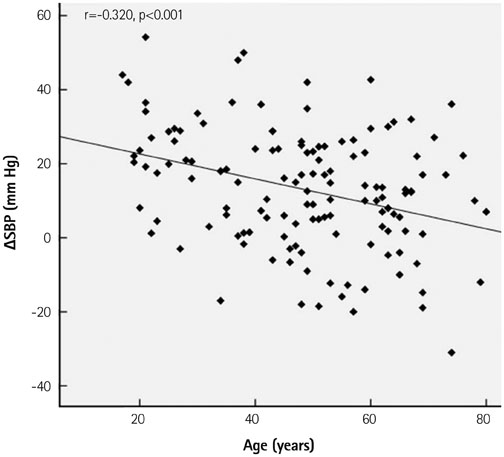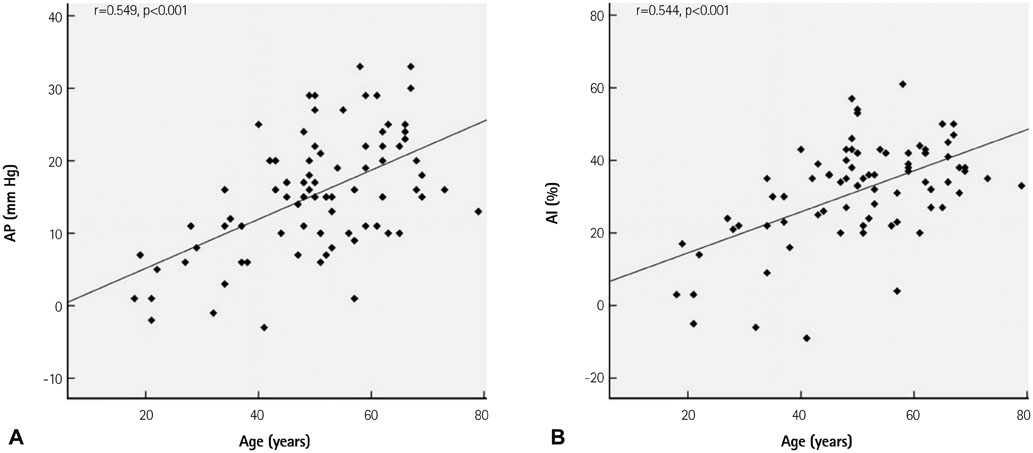Korean Circ J.
2015 Jan;45(1):44-50. 10.4070/kcj.2015.45.1.44.
Effects of Age on Arterial Stiffness and Blood Pressure Variables in Patients with Newly Diagnosed Untreated Hypertension
- Affiliations
-
- 1Department of Internal Medicine, Christian Hospital, Gwangju, Korea.
- 2Department of Cardiology, Translational Research Center on Aging, Chonnam National University Hospital, Gwangju, Korea. christiankyehun@hanmail.net
- KMID: 2223845
- DOI: http://doi.org/10.4070/kcj.2015.45.1.44
Abstract
- BACKGROUND AND OBJECTIVES
To investigate the impact of age on arterial stiffness and blood pressure (BP) variables in newly diagnosed untreated hypertension (HT).
SUBJECTS AND METHODS
A total of 144 patients with newly diagnosed untreated HT were divided into two groups: young group (age < or =50 years, n=71), and old group (age >50 years, n=73). BP variables were measured on office or 24 hours ambulatory BP monitoring (ABPM). Parameters of arterial stiffness were measured on pulse wave velocity (PWV). Pulse wave analysis (PWA) was compared.
RESULTS
Although office BP and pulse pressure (PP) were significantly (p<0.05) higher in the young group than in the old group, BP and PP on ABPM were not significantly different. Central systolic BP and PP, augmentation pressure, augmentation index on PWA, and PWV were significantly higher or faster in the old group compared to that in the young group. Age showed significant positive correlation with both PWV and PWA variables in the young group with HT. However, age only showed significant positive correlation with PWV in the old group with HT. In the young group with HT, PWA variable showed better correlation with age than PWV.
CONCLUSION
Considering BP levels on ABPM, office BP is prone to be overestimated in young patients with HT. Parameters of arterial stiffness measured by PWV and PWA were more affected by age rather than by BP level in patients with HT. Therefore, PWA variable might be a more sensitive marker of arterial stiffness in young patients with HT. However, PWV might be a better marker for old patients with HT.
Keyword
Figure
Reference
-
1. Rutan GH, Kuller LH, Neaton JD, Wentworth DN, McDonald RH, Smith WM. Mortality associated with diastolic hypertension and isolated systolic hypertension among men screened for the Multiple Risk Factor Intervention Trial. Circulation. 1988; 77:504–514.2. Turnbull F. Blood Pressure Lowering Treatment Trialists' Collaboration. Effects of different blood-pressure-lowering regimens on major cardiovascular events: results of prospectively-designed overviews of randomised trials. Lancet. 2003; 362:1527–1535.3. McManus RJ, Caulfield M, Williams B. National Institute for Health and Clinical Excellence. NICE hypertension guideline 2011: evidence based evolution. BMJ. 2012; 344:e181.4. Staessen JA, Bieniaszewski L, O'Brien E, et al. Nocturnal blood pressure fall on ambulatory monitoring in a large international database. The "Ad Hoc' Working Group. Hypertension. 1997; 29(1 Pt 1):30–39.5. Phillips RA, Butkevich A, Sheinart KF, Tuhrim S. Dipping is superior to cusums analysis in assessment of the risk of stroke in a case-control study. Am J Hypertens. 2001; 14(7 Pt 1):649–652.6. Verdecchia P, Schillaci G, Borgioni C, Ciucci A, Pede S, Porcellati C. Ambulatory pulse pressure: a potent predictor of total cardiovascular risk in hypertension. Hypertension. 1998; 32:983–988.7. Zweiker R, Eber B, Schumacher M, Toplak H, Klein W. "Non-dipping" related to cardiovascular events in essential hypertensive patients. Acta Med Austriaca. 1994; 21:86–89.8. Khattar RS, Senior R, Swales JD, Lahiri A. Value of ambulatory intraarterial blood pressure monitoring in the long-term prediction of left ventricular hypertrophy and carotid atherosclerosis in essential hypertension. J Hum Hypertens. 1999; 13:111–116.9. Sega R, Facchetti R, Bombelli M, et al. Prognostic value of ambulatory and home blood pressures compared with office blood pressure in the general population: follow-up results from the Pressioni Arteriose Monitorate e Loro Associazioni (PAMELA) study. Circulation. 2005; 111:1777–1783.10. Lee SJ, Park SH. Arterial ageing. Korean Circ J. 2013; 43:73–79.11. Boutouyrie P, Tropeano AI, Asmar R, et al. Aortic stiffness is an independent predictor of primary coronary events in hypertensive patients: a longitudinal study. Hypertension. 2002; 39:10–15.12. Meaume S, Benetos A, Henry OF, Rudnichi A, Safar ME. Aortic pulse wave velocity predicts cardiovascular mortality in subjects >70 years of age. Arterioscler Thromb Vasc Biol. 2001; 21:2046–2050.13. Sutton-Tyrrell K, Najjar SS, Boudreau RM, et al. Elevated aortic pulse wave velocity, a marker of arterial stiffness, predicts cardiovascular events in well-functioning older adults. Circulation. 2005; 111:3384–3390.14. Blacher J, Guerin AP, Pannier B, Marchais SJ, Safar ME, London GM. Impact of aortic stiffness on survival in end-stage renal disease. Circulation. 1999; 99:2434–2439.15. Pannier B, Guérin AP, Marchais SJ, Safar ME, London GM. Stiffness of capacitive and conduit arteries: prognostic significance for end-stage renal disease patients. Hypertension. 2005; 45:592–596.16. Willum-Hansen T, Staessen JA, Torp-Pedersen C, et al. Prognostic value of aortic pulse wave velocity as index of arterial stiffness in the general population. Circulation. 2006; 113:664–670.17. Mattace-Raso FU, van der Cammen TJ, Hofman A, et al. Arterial stiffness and risk of coronary heart disease and stroke: the Rotterdam Study. Circulation. 2006; 113:657–663.18. Pauca AL, O'Rourke MF, Kon ND. Prospective evaluation of a method for estimating ascending aortic pressure from the radial artery pressure waveform. Hypertension. 2001; 38:932–937.19. Williams B, Lacy PS, Thom SM, et al. Differential impact of blood pressure-lowering drugs on central aortic pressure and clinical outcomes: principal results of the Conduit Artery Function Evaluation (CAFE) study. Circulation. 2006; 113:1213–1225.20. Tsai PS. Determinants of the white-coat effect in normotensives and never-treated mild hypertensives. Clin Exp Hypertens. 2003; 25:443–454.21. Dolan E, Stanton A, Atkins N, et al. Determinants of white-coat hypertension. Blood Press Monit. 2004; 9:307–309.22. Staessen JA, O'Brien ET, Atkins N, Amery AK. Short report: ambulatory blood pressure in normotensive compared with hypertensive subjects. The Ad-Hoc Working Group. J Hypertens. 1993; 11:1289–1297.23. Pickering TG, James GD, Boddie C, Harshfield GA, Blank S, Laragh JH. How common is white coat hypertension? JAMA. 1988; 259:225–228.24. Pickering T. Ambulatory blood pressure monitoring: an historical perspective. Clin Cardiol. 1992; 15:5 Suppl 2. II3–II5.25. Park SH, Bang DW, Seo J, et al. Comparison of the ambulatory blood pressure with the clinical blood pressure and electrocardiographic left ventricular hypertrophy. Korean J Med. 2007; 72:181–190.26. Roman MJ, Devereux RB, Kizer JR, et al. Central pressure more strongly relates to vascular disease and outcome than does brachial pressure: the Strong Heart Study. Hypertension. 2007; 50:197–203.27. Agabiti-Rosei E, Mancia G, O'Rourke MF, et al. Central blood pressure measurements and antihypertensive therapy: a consensus document. Hypertension. 2007; 50:154–160.28. McEniery CM, Yasmin , Hall IR, et al. Normal vascular aging: differential effects on wave reflection and aortic pulse wave velocity: the Anglo-Cardiff Collaborative Trial (ACCT). J Am Coll Cardiol. 2005; 46:1753–1760.
- Full Text Links
- Actions
-
Cited
- CITED
-
- Close
- Share
- Similar articles
-
- Effects of Valsartan on Carotid Arterial Stiffness in Patients with Newly Diagnosed Hypertension: A Comparative Study with Global Arterial Stiffness
- Arterial stiffness and hypertension
- Effect of Obesity on Blood Pressure and Arterial Stiffness in Middle-Aged Korean Women
- Hypertension and Vascular Aging
- Arterial stiffness and hypertension




